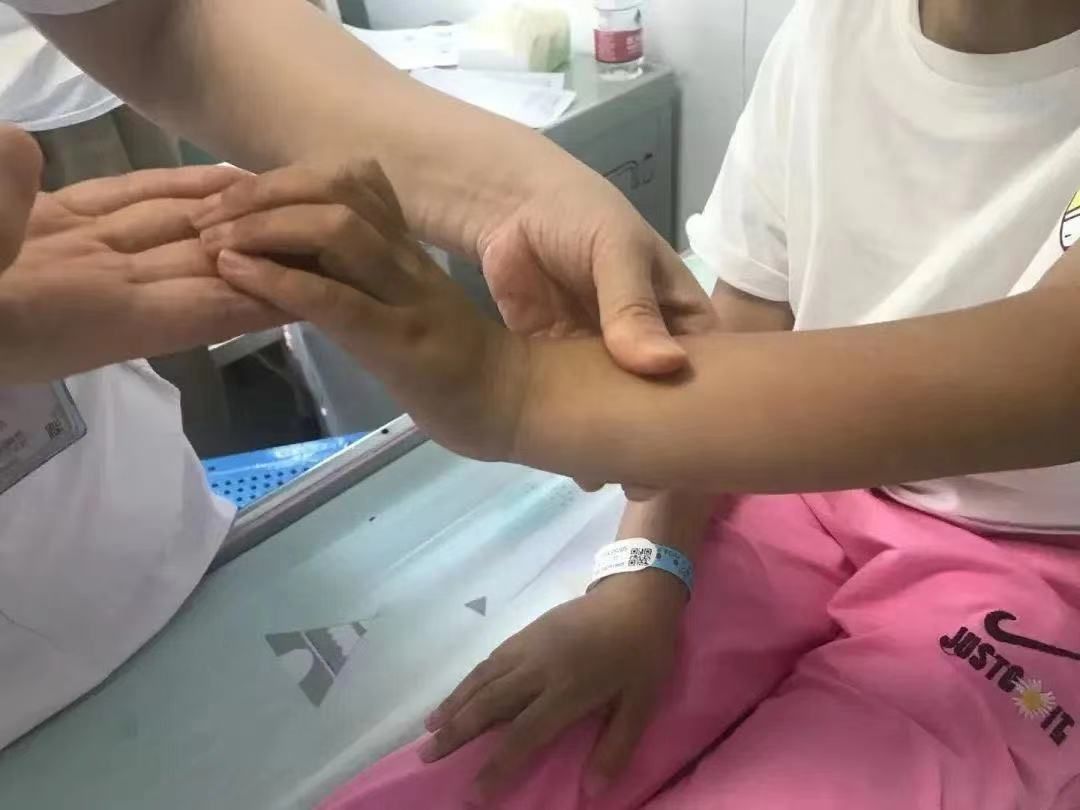- Triumph Over the World’s First Case of a Rare Disease: The Second Affiliated Hospital of WMU Successfully Treats an 11-Year-Old Girl the Same Size of a 7-Year-Old Child in Height
- Author: Date:July 17, 2023
How to treat a disease that had never been diagnosed anywhere in the world? At the age of 11, the girl’s height was the same as that of a 7-year-old child and even walking was difficult for her. Recently, the Second Affiliated Hospital of Wenzhou Medical University has successfully diagnosed and treated the world's first case of the rare disease LIRSA, an autoinflammatory disorder caused by a mutation in IL-1R1 resulting in chronic recurrent multifocal osteomyelitis.
An Unknown Inflammation that Deprived Her of Happiness
Lily (pseudonym) started experiencing swelling and pain in her lower limb joints at the age of one. The hospital she visited then diagnosed the disease as osteomyelitis and carried out surgery for her. However, the pathogen resulting in inflammation was not found after the surgery, nor did the antiphlogistic drugs work, leaving her parents extremely anxious. How could a disease be incurable? They sought medical help everywhere and visited multiple hospitals. But neither surgeries nor pharmaceutical treatment helped. As time went on, walking became increasingly challenging for Lily, let alone physical exercises.
After 11 years of battle with illness, she was only 122 cm in stature, equivalent to that of a 7-year-old child, causing her to feel inferior and voiceless amongst her peers.

Lily is significantly shorter in height compared to her peers before treatment.
In August 2020, Dr. Zheng Wenjie received Lily at her outpatient clinic at the Second Affiliated Hospital of WMU. The fact that Lily had an early onset of the disease with a long medical history and multiple joint involvement immediately rang alarm bells. Dr. Zheng admitted her to the hospital for further examination. The comprehensive examination revealed that Lily's disease differed from the common juvenile idiopathic arthritis, as the lesions were not only in the joints but had also extended into the bone marrow and affected multiple parts of her body, including the radius, ulna, tibia, fibula, femur, and sacroiliac joints. Additionally, her wrists were unable to flex or extend normally, and her knees exhibited outward deviation and limited extension. Lily's serum amyloid A protein (SAA) level reached 580, 58 times higher than the normal value.

Her wrists cannot bend properly before treatment.
Joining hands to unmask the underlying cause of the disease
Dr. Zheng facilitated a multidisciplinary consultation for Lily's arthritis and a rare diagnosis of chronic recurrent multifocal osteomyelitis (CRMO) was made. Despite some improvement in joint swelling and pain, the treatment failed to improve the bone marrow edema or lower Lily's inflammatory markers to normal levels. Dr. Zheng suspected that Lily might have a rare autoinflammatory disease. However, as the results of the whole-exome sequencing came back negative, the diagnosis and treatment seemed to hit a brick wall.
What exactly was the disease? To find out, Dr. Zheng reached out to Professor Zhou Qing from the Life Sciences Institute at Zhejiang University. Prof. Zhou is an expert in autoinflammatory diseases and the discoverer of multiple such disorders. Prof. Zhou and her research team conducted another thorough analysis of Lily's genetic data and surprisingly discovered a de novo K131E mutation in Lily's IL-1R1 gene. This mutation hindered the binding of the IL-1 receptor to its antagonist IL-1Ra, leading to systemic hyperinflammation in the child. Through a series of cytobiology and animal experiments, the pathogenicity of IL-1R1 K131E was confirmed, thus uncovering the true culprit behind Lily's high levels of inflammatory cytokines.

After 13 months of treatment, Lily's height increased by 13 centimeters, and she is now only slightly shorter than her mother.
In light of the biological characteristics of Lily's gene mutation, targeted biological drugs were deemed the most suitable option. However, selection of medication for a rare disease that had never been reported before was a serious clinical challenge. After organizing numerous internal and external expert discussions and obtaining the approval from the medical ethics committee, Dr. Zheng administered the selective IL-1β inhibitor, canakinumab, to Lily. Surprisingly, after more than a year of treatment, Lily's joint swelling and pain significantly improved, her inflammatory markers returned to normal levels, and most importantly, the bone marrow edema noticeably subsided. At present, Lily is able to run and jump rope, and her height has reached 142 centimeters. Furthermore, she becomes a much more cheerful person.
An entry in the "Online Mendelian Inheritance in Man" database
After consulting relevant information, it has been found that this is the first reported case of an autoinflammatory disease caused by an IL1R1 gene mutation worldwide. Prof. Zhou and Dr. Zheng named this new type of autoinflammatory disease Loss of IL-1R1 Sensitivity to IL-1Ra (LIRSA). The research result was published on June 13, 2023, in the prestigious immunology journal "Immunity". The study not only, for the first time, identified the pathogenic gene IL1R1 leading to chronic recurrent multifocal osteomyelitis but also provided targeted treatment for the patient based on this discovery, achieving excellent therapeutic results. "This research represents the contribution of Chinese healthcare professionals to conquering immune-related diseases for all of humanity," said Dr. Zheng Wenjie, one of the co-first authors of the study and the Director of the Pediatric Rheumatology Department at the Second Affiliated Hospital of Wenzhou Medical University.

Autoinflammatory diseases are a group of rheumatic immune disorders characterized by systemic and organ-specific inflammation, often with genetic heterogeneity resulting from innate immune pathway dysregulation. To explain further, Dr. Zheng Wenjie drew an analogy between inflammation in the body and fire. In these diseases, the fire within the body continues to burn intensely due to spontaneous activation of pro-inflammatory pathways, while the lack of firefighters (deficient anti-inflammatory pathways) fails to control the fire. This results in recurrent or periodic fever, rash, serositis, arthritis, and even organ damage involving vision, hearing, liver, and kidney function.

Although autoinflammatory diseases are rare, once diagnosed, most cases can be treated with targeted drugs specific to the inflammatory pathways involved. Early diagnosis and treatment can minimize organ damage and greatly improve a child's quality of life. Lily's case, as the world's first reported instance of a new autoinflammatory disease caused by IL-1R1 mutation, will be included in the "Online Mendelian Inheritance in Man" database. This database provides up-to-date information on human genes and genetic disorders worldwide.
Text translated by Hong Yanggang and reviewed by Sun You
